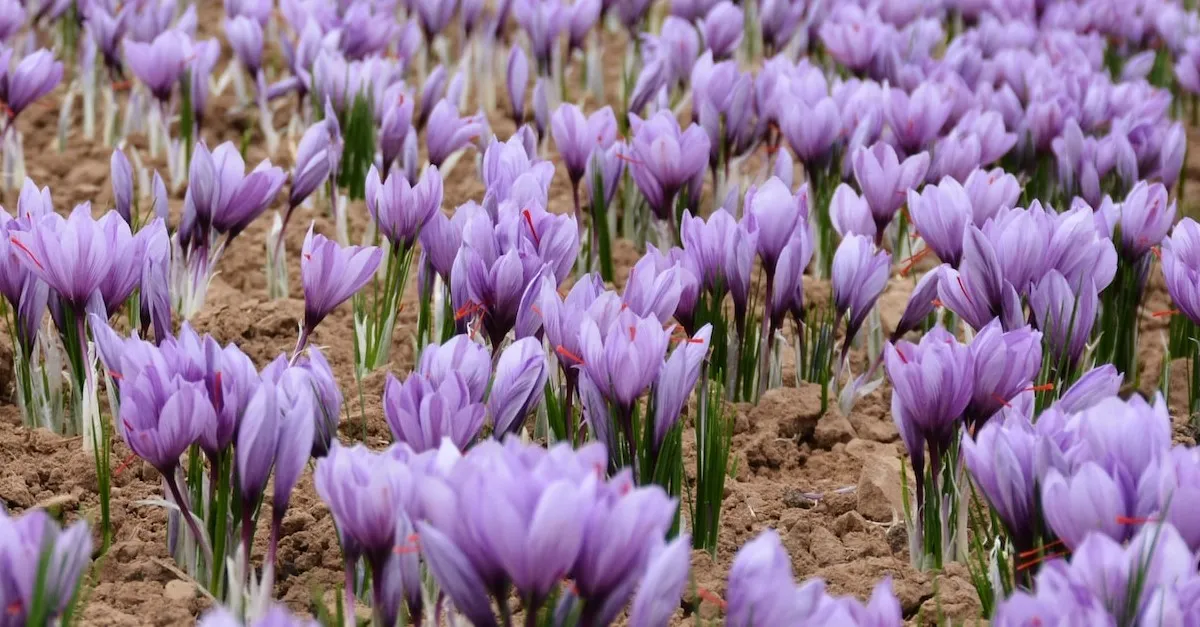How To Grow Saffron In Texas: A Complete Guide
With its beautiful purple flowers and delicate threads, saffron is the world’s most expensive spice. Traditionally grown in parts of Europe and Asia, many budding gardeners wonder if it’s possible to cultivate this exotic plant in the hot Texas climate.
If you’re short on time, here’s a quick answer to your question: Yes, growing saffron is possible in Texas with the right soil preparation, irrigation, and a little winter dormancy period. The key is replicating the Mediterranean-like climate saffron thrives in.
This in-depth guide will cover everything Texas gardeners need to successfully grow saffron at home. You’ll learn ideal planting locations, soil and watering requirements, how to harvest saffron threads, and where to buy bulbs. Let’s get started growing red gold in the Lone Star State!
Saffron Growing Conditions
Climate Needs
Saffron is a delicate and unique crop that requires specific growing conditions to thrive. In Texas, saffron can be successfully grown in areas with a Mediterranean or subtropical climate. This means that the regions with mild winters and hot, dry summers are ideal for saffron cultivation.
The temperature range should be between 50 and 90 degrees Fahrenheit, with a significant difference between day and night temperatures. Saffron bulbs require a period of cool temperatures, usually around 50 degrees Fahrenheit, to trigger flowering.
Soil Requirements
The soil plays a crucial role in the successful growth of saffron. It needs to be well-draining and rich in organic matter. Sandy loam or loamy soil is considered ideal for saffron cultivation. The pH level of the soil should be between 6 and 8, slightly acidic to neutral.
Before planting saffron bulbs, it is recommended to prepare the soil by adding compost or well-rotted manure to improve its fertility and drainage.
Planting Locations
When choosing a location for saffron cultivation in Texas, it is important to consider factors such as sunlight exposure and protection from strong winds. Saffron plants require full sun, at least 6 to 8 hours of direct sunlight per day.
They should be planted in an area that is sheltered from strong winds, as the delicate flowers can be easily damaged. It is also advisable to select a location that is away from trees or other plants that may compete for nutrients and water.
For more detailed information on saffron growing conditions, you can visit www.saffronbulbs.com. They provide comprehensive guides and tips for successful saffron cultivation.
Planting and Caring for Saffron
When to Plant
Timing is crucial when it comes to planting saffron in Texas. Saffron bulbs should be planted in the fall, ideally in late September or early October. This allows the bulbs to establish their roots before the cold winter arrives.
Planting too late in the season may result in poor growth or even failure to bloom. It’s important to note that saffron is a perennial plant, meaning it will come back year after year if properly cared for.
Preparing Soil
Before planting saffron bulbs, it’s important to prepare the soil properly. Saffron thrives in well-draining soil with a pH level between 6.0 and 8.0. Adding organic matter, such as compost or well-rotted manure, can improve soil fertility and drainage.
It’s also recommended to perform a soil test to determine any nutrient deficiencies or imbalances that may need to be addressed.
Irrigation Tips
Saffron requires regular irrigation, especially during the growing season. However, it’s important to avoid overwatering, as this can lead to bulb rot. A good rule of thumb is to keep the soil evenly moist, but not waterlogged.
Mulching around the saffron plants can help retain moisture and suppress weed growth. It’s also important to water saffron plants early in the day to allow the foliage to dry before evening, reducing the risk of fungal diseases.
Fertilization
Saffron plants benefit from regular fertilization to ensure healthy growth and maximize yield. A balanced fertilizer with a ratio of 10-10-10 or 14-14-14 can be applied in early spring before the plants start actively growing.
It’s important to follow the manufacturer’s instructions for application rates and timing. Additionally, organic fertilizers, such as compost or well-rotted manure, can be applied in the fall to provide nutrients for the following growing season.
Pest and Disease Control
Saffron is generally a low-maintenance plant, but it may be susceptible to certain pests and diseases. Common pests that can affect saffron include aphids, spider mites, and thrips. These can be controlled through regular monitoring and the use of organic insecticides if necessary.
As for diseases, saffron may be prone to fungal infections, such as root rot and leaf spot. Proper watering practices, good airflow, and regular inspection of the plants can help prevent and manage these issues.
Harvesting Saffron
Harvesting saffron is an exciting and rewarding process that requires careful timing and attention to detail. Saffron is a spice derived from the flower of the Crocus sativus plant, and it is known for its vibrant red color and unique flavor.
When it comes to harvesting saffron in Texas, there are a few important steps to follow for a successful harvest.
Timing
The timing of saffron harvest is crucial, as the flowers must be picked at the right moment to ensure the highest quality saffron threads. In Texas, saffron flowers typically bloom in the fall, usually around October or November.
It is important to monitor the flowers closely and harvest them as soon as they open fully. This is usually early in the morning when the flowers are still fresh and the weather is cooler.
Picking the Flowers
When harvesting saffron, it’s important to handle the flowers with care to avoid damaging the delicate threads. Gently pluck the flowers from the base, being careful not to pull too hard and tear the petals.
It’s best to use your fingers or a small pair of scissors to cut the flowers just above the base.
Separating the Stigmas
After picking the saffron flowers, it’s time to separate the stigmas, which are the part of the flower that contains the valuable saffron threads. The stigmas are usually deep red in color and can be easily identified. Gently pinch the base of the stigma and pull it away from the flower.
Be sure to remove any yellow or white parts, as they are not usable.
Drying and Storing
Once the stigmas have been separated, they need to be dried to preserve their flavor and aroma. Spread the stigmas out in a single layer on a clean, dry surface, such as a baking sheet or a mesh screen. Place them in a cool, dry place with good air circulation, away from direct sunlight.
Allow the stigmas to dry completely, which usually takes about two weeks.
After the saffron threads are fully dried, store them in an airtight container in a cool, dark place. Properly stored saffron can last for up to two years without losing its flavor and potency.
Harvesting saffron can be a labor-intensive process, but the end result is well worth it. The vibrant color, distinct flavor, and numerous health benefits make saffron a highly sought-after spice. Whether you’re a seasoned saffron grower or a beginner, following these steps will help you successfully harvest saffron in Texas.
Storing and Using Homegrown Saffron
Once you have successfully harvested your saffron threads from your homegrown saffron crocus plants, it’s important to store them properly to maintain their flavor and quality. Here are some tips on how to store and use your homegrown saffron:
1. Storage Containers
Use airtight containers such as glass jars or metal tins to store your saffron threads. Make sure the containers are clean and dry before transferring the saffron. Avoid using plastic containers as they may absorb the aroma and affect the quality of the saffron.
2. Dark and Cool Location
Saffron is sensitive to light and heat, so it’s best to store it in a dark and cool location. Direct sunlight can degrade the saffron’s flavor and color over time. A pantry or cupboard away from the stove or other sources of heat is an ideal storage place.
3. Aroma Preservation
Saffron’s distinct aroma is one of its most prized attributes. To preserve the aroma, it’s recommended to store saffron away from strong-smelling spices and ingredients. This will prevent cross-contamination and ensure that your saffron retains its unique fragrance.
4. Shelf Life
Properly stored, saffron can maintain its quality for up to two years. However, it’s best to use it within the first year to enjoy its optimal flavor and color. Over time, saffron may lose its potency, so it’s important to periodically check its freshness before using it in your culinary creations.
5. Using Homegrown Saffron
Now that you have your homegrown saffron, it’s time to put it to good use! Saffron is a versatile spice that can elevate both sweet and savory dishes. It pairs well with rice, seafood, chicken, and desserts.
Here are a few ideas for using your homegrown saffron:
- Add a pinch of saffron to your rice dishes for a vibrant yellow color and delicate flavor.
- Infuse saffron into warm milk or water to create a fragrant base for desserts like puddings, custards, and ice creams.
- Sprinkle saffron threads over roasted vegetables or grilled meats for an exotic touch.
- Experiment with saffron-infused syrups or sauces to drizzle over cakes, pastries, or pancakes.
Remember to use saffron sparingly as it is a potent spice. A little goes a long way, and too much can overpower the dish.
For more information about storing and using saffron, you can visit The Spice House website, which provides detailed guidelines on saffron storage and usage.
Where to Buy Saffron Bulbs in Texas
When it comes to growing saffron in Texas, the first step is to find a reliable source for saffron bulbs. Saffron bulbs, also known as corms, are the starting point for cultivating this valuable spice. Fortunately, there are several options available for purchasing saffron bulbs in Texas.
Local Nurseries and Garden Centers
One option is to check with local nurseries and garden centers in your area. These establishments often carry a variety of plants and may have saffron bulbs available for purchase. It’s a good idea to call ahead and inquire about their stock, as saffron bulbs may not be a common item.
Online Retailers
Another convenient option is to buy saffron bulbs online. There are numerous online retailers that specialize in selling saffron bulbs and other exotic plants. One popular online retailer is www.saffronbulbs.com, which offers a wide selection of saffron bulbs suitable for Texas climate.
Saffron Farms
For those who prefer a more hands-on approach, visiting a saffron farm is a great option. Not only can you purchase saffron bulbs directly from the source, but you can also gain valuable insights and tips from experienced saffron growers.
Some saffron farms in Texas even offer guided tours and workshops for those interested in learning more about saffron cultivation.
It’s important to note that saffron bulbs are typically sold in the fall, as they need a period of dormancy during the winter months. Therefore, it’s advisable to plan ahead and start your search for saffron bulbs in late summer or early fall.
Remember, saffron cultivation requires careful attention to detail and the right growing conditions. So, before purchasing saffron bulbs, make sure you have a suitable location with well-drained soil, ample sunlight, and proper irrigation.
With the right bulbs and proper care, you can enjoy the beauty and flavor of homegrown saffron in your Texas garden.
Conclusion
With proper soil preparation, irrigation, fertilization, and winter dormancy, Texas gardeners can experience the joy of growing saffron at home. Follow this guide for tips on replicating the hot, dry Mediterranean climate saffron thrives in.
Plant saffron bulbs in the fall for gorgeous purple blooms and red stigmas ready for harvest in autumn. Store the delicate threads properly to enjoy this exotic, fragrant spice’s flavor and color-changing properties for months to come.








